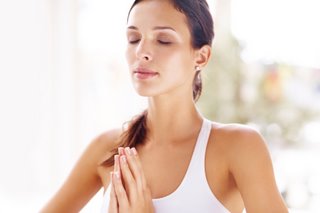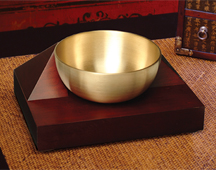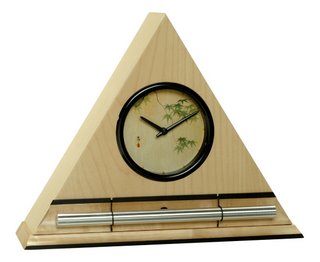
yoga and menopausal hormones
Menopausal hormone shifts can rearrange your body and mind in unnerving ways. Let yoga bring you back into balance.
Clients at Kay Lee’s hair salon in Studio City, California, have gotten used to seeing its owner standing on her hands in a corner of the room. Lee, who’s 51, has been practicing yoga since she was in her early 20s. But she began a more dedicated practice about six years ago, when she realized she needed help managing the symptoms of perimenopause. “I was around lots of older women at the salon, and we would all talk about the changes we were going through,” she says. “Watching them go through their menopause, I realized I needed to find a good way to cope with it.”
Like many other women, Lee suspected that menopause might bring unpleasant symptoms. But when, in her 40s, she began experiencing perimenopause—a constellation of premenopausal changes that often includes hot flashes, insomnia, anxiety, irregular periods, heavy bleeding, forgetfulness, and fatigue—she discovered that she was unprepared.
For Lee, the symptoms that hit hardest were irritability and mood swings. She’d grown accustomed to juggling midlife responsibilities: running her business and household, tending to her marriage, raising two children. But her emotions sometimes flared out of control as she moved into perimenopause. The worst episodes occurred during her two-hour freeway commute from her home in Ojai, California, to the salon, and back again—a drive that grew more frustrating the deeper into perimenopause she got. “Road rage,” she says ruefully. “I would have a lot of road rage.”
Between the aggression, sleepless nights, and hot flashes, Lee decided she needed help. She knew women from the salon who were using hormone therapy, typically a combination of the female hormones estrogen and progesterone, but Lee wanted a more natural approach. She had taken classes sporadically in the past with Ojai yoga teacher Suza Francina, author of Yoga and the Wisdom of Menopause. Now that Lee needed help with the menopausal transition, she started going to Francina’s classes two to three times a week. She also began taking breaks during her busy workday to spend at least a few minutes doing yoga.
Fog-free zone
After several weeks of regular practice, Lee felt much better: Her moods stabilized, and her thinking became sharper. Even her PMS symptoms improved. Longtime yogis, of course, know that the practice can bring benefits like calmness, mental clarity, strength, and focus to people of any age. But for women experiencing the physical, mental, and emotional throes of the menopausal years, yoga’s gifts are particularly welcome.
“Menopause is like going through puberty, only in reverse,” Francina says. “By replenishing energy and soothing the nervous system, yoga goes to the root of a wide range of symptoms,” she says. Yoga teachers like Francina aren’t the only people who think that yoga can help. Because hormone therapy can raise the risk of heart disease, stroke, blood clots, and breast cancer, medical researchers have been searching for gentler ways to ease women through the menopausal transition. Although the research is still in its early stages, several studies have pointed to important ways that yoga can make a difference.
In 2005 Beth Cohen, an internist at both the University of California, San Francisco, and San Francisco VA Medical Center, studied the effects of yoga on hot flashes in a small pilot study of 14 women. The women in the study took part in a weekly 90-minute yoga class designed around eight restorative poses. They also practiced for one hour at home three days a week. After eight weeks, the frequency of the women’s hot flashes decreased by 30 percent and their severity diminished by 34 percent. Cohen suspects that the results may be due to yoga’s ability to calm the sympathetic nervous system, although she can’t yet be certain, because researchers don’t fully understand what causes hot flashes.
Cohen says that the study also revealed some unexpected findings, such as improved sleep among the participants. But since the study didn’t include a control group, it’s hard to say whether some of the response can’t be chalked up to the placebo effect. Last year, however, researchers in Bangalore, India, examined how yoga affected menopausal symptoms in a larger group of 120 women, this time with a comparison group. Half the women took yoga classes five days a week for an hour a day, while the others did supervised gentle exercise. After eight weeks, the yoga group had substantially fewer menopausal symptoms—hot flashes, memory problems, and sleep disturbances—as well as lower scores on a measure of perceived stress. There’s also evidence that yoga can do more than just ease bothersome symptoms. Kim Innes, assistant professor at the University of Virginia’s Center for the Study of Complementary and Alternative Therapies, reviewed the medical literature about ways that yoga (and other mind-body practices, including tai chi) may affect the physiological and neuropsychological processes that contribute to the increase in heart disease risk for postmenopausal women.
The hormonal changes that occur during menopause, particularly the sharp drop in estrogen, can lead to numerous health changes that make women much more vulnerable to heart disease and other chronic conditions. For instance, menopause itself is associated with a rise in insulin resistance and other adverse changes, including high blood pressure. Insulin resistance is a precursor to diabetes, in which the body becomes less sensitive to insulin, in turn causing blood-sugar levels to rise. In addition the menopausal transition is associated with increased activation of the sympathetic nervous system and related deterioration in both mood and sleep. All of these factors are interrelated, and all raise the risk for heart disease.
Yoga, Innes says, has been shown to counter these risk factors. “I wasn’t expecting to see such a widespread effect on so many parameters,” she says. “But the more you look, the more you see that so many of these are related to stress. And the thing that’s startling is how quickly these beneficial changes can occur, even over the course of six weeks or less.”
Restoratives to the Rescue
No single sequence will provide surefire relief for every woman, says Elise Browning Miller, an Iyengar Yoga teacher in Palo Alto, California, who teaches workshops on yoga for menopause. Browning Miller and other teachers agree on a few general principles for practicing during menopause.
Women who are experiencing a lot of emotional turmoil may find standing poses like Prasarita Padottanasana (Wide-Legged Standing Forward Bend) to be grounding and stabilizing, says Browning Miller. If heavy bleeding is a problem, inversions such as Salamba Sarvangasana (Supported Shoulderstand) can help reduce bleeding, she says.
For postmenopausal women who want to maintain strong bones and prevent the wrist fractures common among this group, Miller recommends practicing asanas that put weight on the hands and forearms. These include poses such as a supported version of Adho Mukha Svanasana (Downward-Facing Dog Pose), using a strap around the elbows or putting the forearms on the floor. Resting the head on the floor or on a block during the pose can also help ease emotional upset.
But for many women during this time, restorative poses are the most crucial asanas of all. “When your body is going through changes, you need more rest,” Francina says. “No aspect of yoga is more important during this time than to take time every day to practice at least one restorative pose. This is a time for a peaceful, deep approach, with plenty of props so you can enjoy staying in poses longer.”
Life Support
As for how often to practice, the consensus is at least twice a week: “Enough that you let it spill into your life,” Miller says. “There’s something about twice a week that has a multiplicative effect.”
Lee says that she can’t imagine her life these days without yoga. She practices at the beginning or end of her day for at least 20 minutes, focusing on restorative poses. And she continues to attend classes at Francina’s studio two or three days a week. The benefits go beyond the physical. Because her mother died at 52, Lee hasn’t had an up-close role model to show her how to move gracefully into the next stage of her life. The women in her yoga classes, some of whom are in their 80s, have helped to fill that void. “Yoga gave me a support group of women who are my elders,” Lee says. “When we practice together, I feel really supported.”
At Lee’s salon, she says, the topics of perimenopause and menopause come up all the time. When women come in for a haircut but wind up telling Lee that they’re fatigued or having mood swings, she passes on yoga tips that might help them feel better. In addition to having her mat at the salon, she also keeps a block, a strap, and a bolster on hand. “I’ve shown so many clients Viparita Karani,” she says. “They initially come for a beauty treatment. I try to remind them that beauty comes from inner balance and health.”
At Rest in Transition
Make restorative poses the core of your practice during the menopausal transition, says yoga teacher and author Suza Francina. “I call these the essential poses for crossing the menopausal bridge. They will carry you to the next phase of your life.” Francina recommends staying in the first two poses for 10 minutes or longer, and the third for 5 minutes or longer.
Supta Baddha Konasana (Reclining Bound Angle Pose), supported
Sit on your mat in front of a bolster placed lengthwise behind you. Loop a strap behind your back at your sacrum. Bring it forward around your hips and over your shins, and secure it under your feet so that it encircles the lower part of your body. Place the soles of your feet together and put a folded blanket or block beneath each of your outer thighs. Lie back with your spine centered on the bolster and with your arms out to the sides, palms up. |
 |
Setu Bandha Sarvangasana (Bridge Pose), supported
Place a bolster or two folded blankets on your mat, and lie back over them so that they support your back rib cage but allow your upper back and shoulders to reach toward the floor. Place the soles of your feet together, cross your shins, or bend the knees and keep feet flat on the floor. More-experienced yogis can practice with the legs straight and the feet on a block. Let your arms rest out to the sides or stretch them overhead with elbows bent and palms facing up. |
 |
Viparita Karani (Legs-up-the-Wall Pose), supported
Place a bolster or two folded blankets about six inches away from the wall (the exact distance depends on your leg flexibility and comfort). Sit sideways on the bolster, with the side of your hip touching the wall. With the bolster under your bottom, lower yourself back and swivel around so that your torso is perpendicular to the wall and your legs are extended up it. Let your arms rest out to the sides, palms up. In the beginning, stay about 5 minutes, and gradually increase the time to 10 minutes or longer. |
 |
adapted from Yoga Journal by Katherine Griffin, a former editor at Yoga Journal, is a San Francisco Bay Area writer.
Our Zen Timepiece’s acoustic 6-inch brass bowl-gong clock is the world’s ultimate alarm clock, practice timer, and “mindfulness bell.” The Singing Bowl Gently reminds you to change position when practicing yoga each day.
This unique “Zen Clock” features a long-resonating acoustic chime that brings the meditation or yoga session to a gradual close, preserving the environment of stillness while also acting as an effective time signal.

Yoga Timer with Singing Bowl - Now & Zen, Inc.

Zen Chime Alarm Clock and Yoga Timer
Now & Zen’s Yoga Timer Shop
1638 Pearl Street
Boulder, CO 80302
(800) 779-6383
Posted in yoga, Yoga Timer, Yoga Timers by Now & Zen